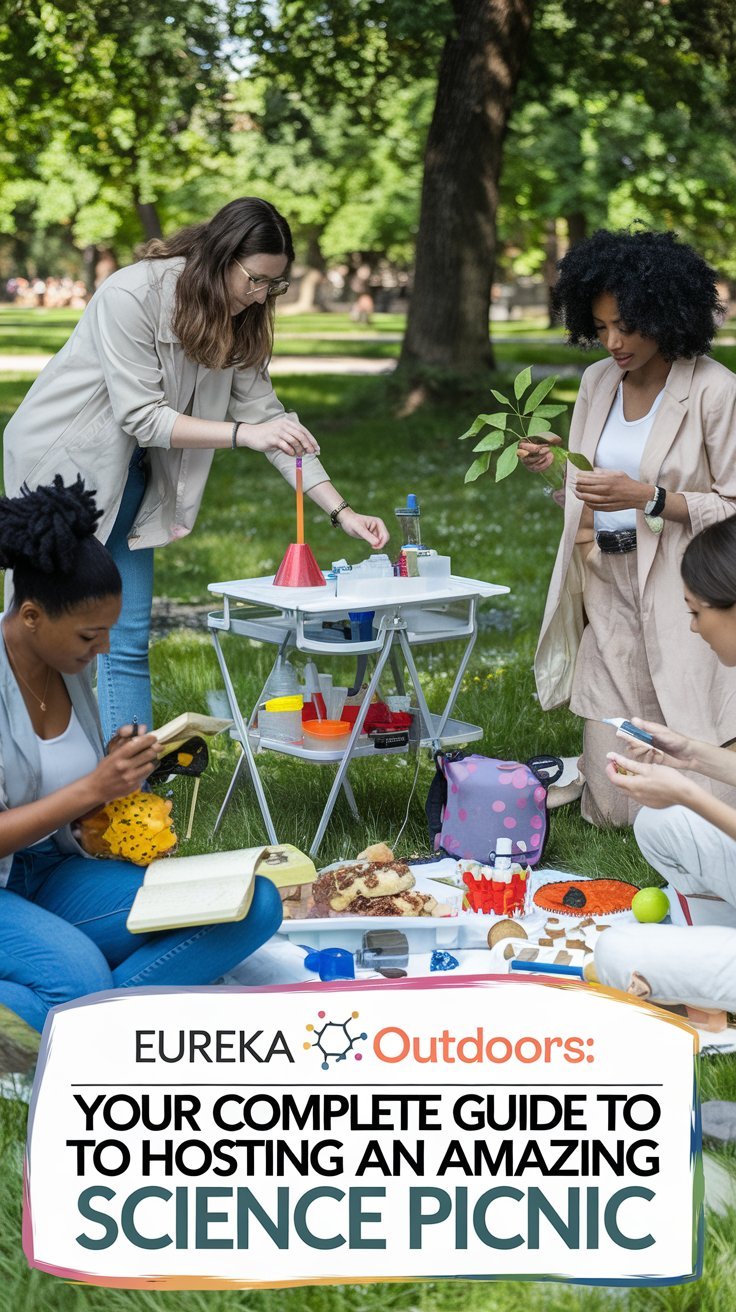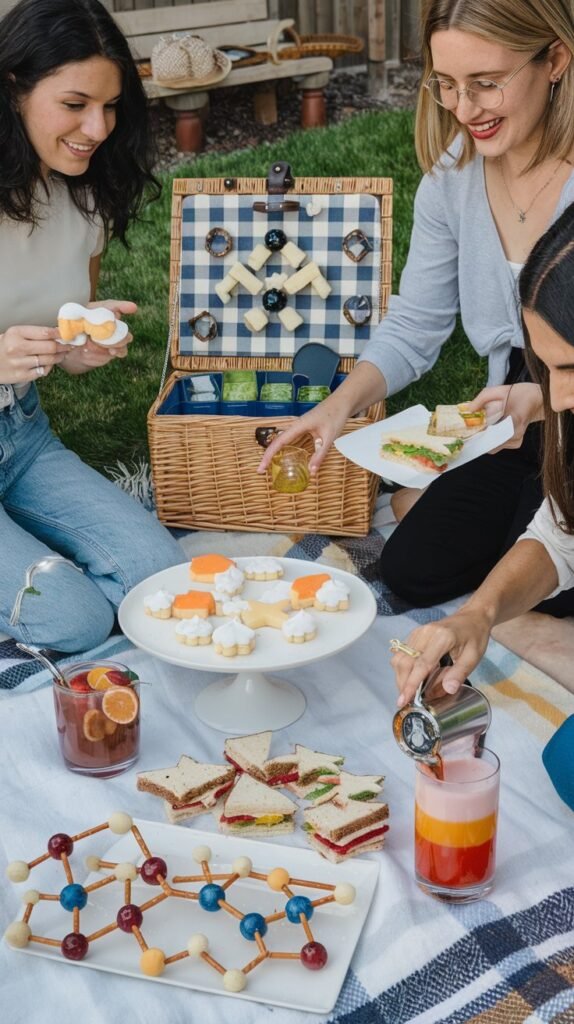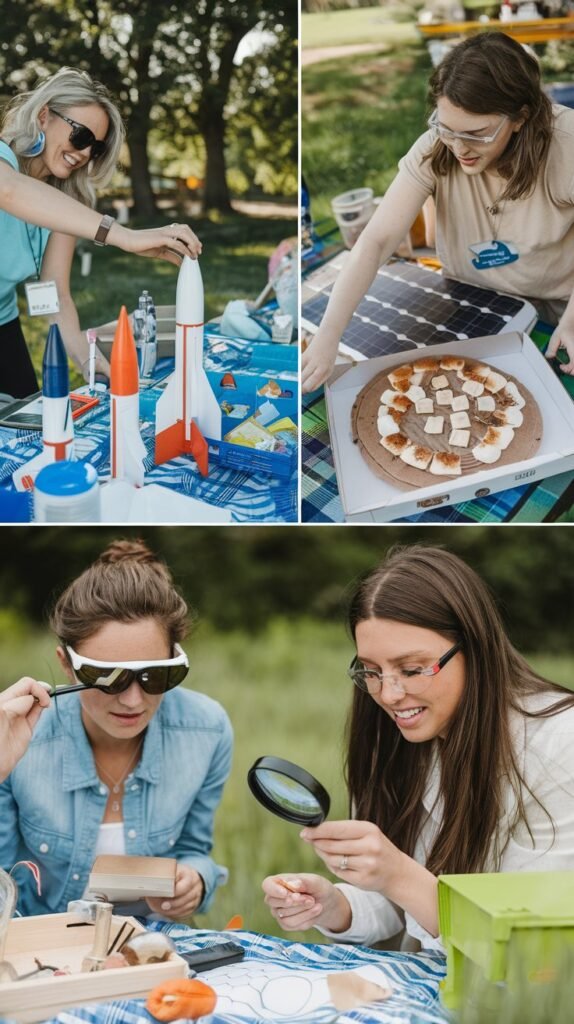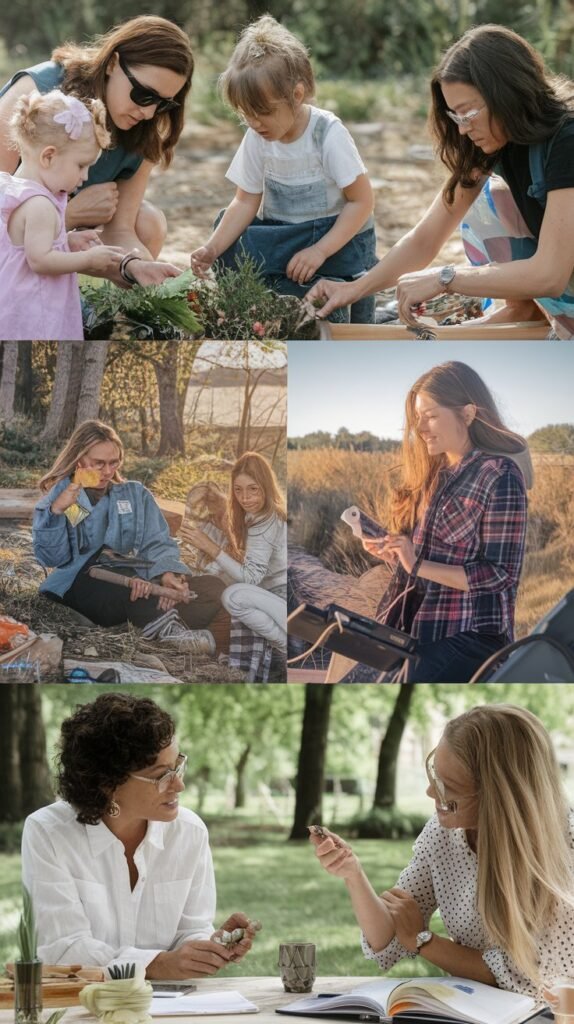Why limit science to laboratories and classrooms when nature provides the perfect setting for discovery and experimentation? A science picnic combines the joy of outdoor dining with the thrill of hands-on learning, creating a unique experience that engages curious minds of all ages. Whether you’re planning an educational family outing, a creative date, or a friend gathering with a cerebral twist, a science-themed picnic offers endless possibilities for fun, learning, and memorable moments.
Let’s dive into everything you need to know to create a picnic experience where curiosity, discovery, and delicious food come together under open skies!
Planning Your Scientific Expedition
A successful science picnic starts with thoughtful preparation that balances structure with room for spontaneous discovery.
Choosing Your Scientific Focus
Consider these engaging themes for your outdoor laboratory:
- Nature Science: Explore ecosystems, identify species, or conduct habitat surveys
- Chemistry in Action: Safe, picnic-friendly reactions and demonstrations
- Physics Playground: Experiment with motion, gravity, or light in open spaces
- Astronomy Afternoon: Daytime sky observation transitioning to evening stargazing
- Geology Adventure: Rock hunting, fossil searching, or soil analysis
- Weather Watchers: Cloud identification, wind experiments, or precipitation studies
- Tech Outdoors: Solar-powered gadgets, nature photography, or outdoor robotics
“We rotate through different science themes for our monthly picnics,” shares Madison, who organizes educational family gatherings. “Last month’s biology focus had us creating food chain diagrams with things we observed. This month we’re doing ‘kitchen chemistry’ with safe reactions using picnic supplies. The changing themes keep everyone curious and engaged every time.”
Location Selection Strategy
Find the perfect outdoor laboratory with these considerations:
- Biological Diversity: Parks with various ecosystems (pond, forest, field)
- Geological Features: Locations with interesting rock formations or soil types
- Open Sky Access: Clear views for astronomy or weather observation
- Water Sources: Streams or ponds for water experiments (with safety in mind)
- Work Surfaces: Areas with picnic tables or flat ground for experiments
- Natural Protection: Trees for shade and wind protection for sensitive activities
- Legal Considerations: Checking park rules about collecting specimens or using equipment
Timing Considerations
Schedule your science picnic for optimal discovery:
- Seasonal Phenomena: Plan around migration patterns, leaf changes, or meteor showers
- Weather Conditions: Some experiments need still air, others benefit from windy days
- Time of Day: Consider shadows for sundials, optimal bird watching hours, or stargazing
- Duration: Allow enough time for both structured activities and free exploration
- Flexibility: Have indoor backup plans for weather-sensitive experiments
“Timing can make or break a science picnic,” advises Elena, who leads community nature programs. “We planned our last geology picnic after a heavy rain when the creek bed was freshly exposed, revealing fossils and interesting rocks that would have been hidden otherwise. Checking natural cycles and weather patterns helps you maximize discovery opportunities.”
Essential Science Picnic Equipment
Pack your outdoor laboratory with tools that facilitate exploration and discovery!
Scientific Tools
Basic equipment for various investigations:
- Observation Tools: Magnifying glasses, portable microscopes, binoculars
- Documentation Supplies: Notebooks, colored pencils, specimen bags
- Measurement Equipment: Rulers, measuring tape, thermometers, scale
- Collection Containers: Small jars, baggies, egg cartons for specimens
- Field Guides: Books for identifying plants, animals, rocks, or stars
- Digital Aids: Weather apps, star maps, plant identification apps
- Safety Gear: Gloves, goggles, hand sanitizer, first aid kit
Experiment-Specific Supplies
Depending on your scientific focus:
- Nature Science: Butterfly nets, bug viewers, plant press
- Chemistry: Baking soda, vinegar, food coloring, small containers
- Physics: Balls of different weights, prisms, bubbles, simple machines
- Astronomy: Solar viewers, star charts, compass, sky mapping tools
- Geology: Rock hammers, sieves, mineral testing kits
- Weather: Wind gauge, rain gauge, cloud charts, barometer
- Sustainability: Solar chargers, recycled craft supplies, water testing kits
Practical Picnic Additions
Don’t forget these practical items:
- Cleanup Supplies: Extra water for experiment cleanup, towels, trash bags
- Surface Protection: Washable tablecloths or tarps for messy experiments
- Shade Solutions: Canopy or umbrella for sun-sensitive activities
- Seating Options: Portable chairs or cushions for observation comfort
- Transport Solutions: Backpacks or rolling carts for equipment
- Documentation Devices: Cameras or smartphones for recording discoveries
“Organization is key for science picnics,” notes Olivia, who teaches outdoor education. “I use a fishing tackle box for small science supplies—each compartment holds different items like magnifiers, test tubes, or specimen containers. Everything stays organized but visible, making it easy to find what we need in the middle of an exciting discovery moment.”
Science-Inspired Picnic Menu
Create a meal that’s as educational as it is delicious!
Educational Edibles
Food ideas that reinforce scientific concepts:
- Molecular Gastronomy: Simple spherification, foams, or unexpected textures
- Edible Models: Molecular structures with fruit and cheese “atoms”
- Geological Layers: Layered dips or sandwiches showing strata
- Solar System Snacks: Planet-themed foods arranged by distance from the “sun”
- Food Chain Demonstration: Snacks representing different trophic levels
- Crystalline Structures: Rock candy, salt crystals, or geometric treats
- Cell Biology: Foods with visible “organelles” like deviled eggs or stuffed peppers
Experimental Eating
Interactive food experiences:
- Taste Test Stations: Explore different taste receptors with sweet, sour, salty, bitter, and umami samples
- Color-Changing Foods: Naturally color-changing teas or pH-reactive cabbage juice demonstrations
- Density Drinks: Layered beverages showing liquid density principles
- States of Matter Sampler: Foods in different states (frozen, liquid, gas-infused)
- Science of Cooking: Compare raw vs. cooked versions of foods to discuss chemical changes
- Fermentation Station: Samples of different fermented foods with explanation cards
Practical Food Solutions
Functional ideas for your scientific feast:
- Mess-Free Options: Foods that won’t interfere with experiments
- Energy-Sustaining Choices: Balanced options for active exploration
- Themed Presentation: Serve drinks in beakers or food in petri dishes
- Recipe Cards: Include the science behind each dish
- Food Safety: Temperature-appropriate storage for outdoor dining
- Hydration Station: Water infused with fruits for continuous refreshment
“For my daughter’s birthday science picnic, we created a ‘Phases of the Moon’ cookie decorating station,” shares Jordan, a parent who loves educational celebrations. “The kids frosted round cookies to show different moon phases while we discussed why the moon appears to change shape. It was a perfect blend of science, creativity, and sweet treats—and the kids actually remembered the moon phases afterward!”
Engaging Science Activities
Keep curious minds active with these picnic-friendly scientific explorations!
Quick Science Demonstrations
Fast, impactful activities with minimal supplies:
- Vinegar and Baking Soda Rockets: Film canister launchers with simple chemicals
- Solar S’mores: Cook treats in a homemade solar oven
- Mentos Geysers: The classic diet soda explosion (in appropriate locations!)
- Soil Core Samples: Extract and examine layers with clear tubes
- Leaf Chromatography: Separate plant pigments with rubbing alcohol
- Static Electricity Tricks: Experiments with balloons and various materials
- Water Tension Experiments: Exploring surface tension with paperclips and pennies
Observation Challenges
Activities that sharpen scientific observation:
- Species Count: How many different living things can you find in one square meter?
- Cloud Classification: Identify and document different cloud formations
- Comparative Collections: Gather and sort items by scientific characteristics
- Sound Mapping: Document all sounds heard from your picnic spot
- Micro Photography: Capture extreme close-ups of natural objects
- Seasonal Detectives: Find evidence of the current season or coming changes
- Pattern Recognition: Identify Fibonacci sequences or geometric patterns in nature
Extended Explorations
Deeper projects that develop over your picnic:
- Sundial Creation: Build and calibrate a simple sundial
- Nature Field Guide: Create a guide to your specific picnic location
- Ecosystem Investigation: Document relationships between species observed
- Weather Prediction: Observe signs and compare to actual changes
- Water Quality Testing: Simple tests for nearby water sources
- Decomposition Detectives: Identify and document decomposers at work
- Wildlife Tracking: Find and identify animal tracks or signs
“Our most successful science picnic activity was creating ‘journey sticks,'” explains Aisha, who leads family nature programs. “Everyone selects a stick and attaches found objects along it in the order they were discovered during our exploration. It becomes a physical timeline of the journey, and discussing each item afterward reveals how differently people observe the same environment. It’s fascinating to see what catches each person’s scientific attention.”
Age-Appropriate Science Adaptations
Tailor your science picnic to engage participants of any age!
Preschool Scientists (Ages 2-5)
- Sensory Explorations: Touching, smelling, and safely tasting natural items
- Color Hunts: Finding objects in nature matching color cards
- Simple Collections: Gathering leaves, rocks, or flowers for sorting
- Weather Watching: Feeling wind, observing clouds, catching rain
- Bug Viewing Jars: Temporary observation of insects with magnifiers
- Nature Art: Creating with found materials
- Wonder Questions: Encouraging questions about observations
Elementary Explorers (Ages 6-10)
- Simple Experiments: Cause and effect demonstrations
- Field Guide Usage: Beginning identification skills
- Nature Journaling: Drawing and describing findings
- Scavenger Hunts: Finding items that fulfill scientific criteria
- Habitat Studies: Observing where and how creatures live
- Weather Measurement: Using simple tools to record conditions
- Collection Projects: Gathering and categorizing by scientific properties
Teen Investigators (Ages 11-17)
- Citizen Science Projects: Contributing to real research databases
- Environmental Monitoring: Testing and recording ecosystem data
- Engineering Challenges: Building solutions with natural materials
- Photography Projects: Documenting scientific phenomena
- Comparative Analysis: Testing hypotheses about natural variations
- Technology Integration: Using apps to enhance observations
- Independent Research: Pursuing individual scientific interests
Adult Enthusiasts
- Detailed Identification: Using advanced field guides and features
- Discussion-Based Exploration: Connecting observations to larger concepts
- Specialized Techniques: More complex scientific methods
- Cross-Disciplinary Connections: Linking science with history, art, or culture
- Teaching Opportunities: Sharing knowledge with others
- Philosophical Dimensions: Exploring scientific ethics and implications
- Skill Development: Learning specific scientific techniques
“The key to multi-age science picnics is layered activities,” shares Taylor, who hosts intergenerational learning events. “When we study pond ecosystems, young children might simply observe and count creatures, elementary kids might categorize what they find, teens might test water quality and document correlations, while adults might discuss watershed management or historical changes. Everyone engages with the same environment at their appropriate level.”
Themed Science Picnic Ideas
Get inspired with these specialized science picnic concepts!
Astronomy Picnic
- Focus: Sky observation, solar system, space science
- Timing: Afternoon extending into evening for star viewing
- Key Activities: Solar viewing (with proper equipment), sundials, star charts
- Food Theme: Galaxy swirl cookies, planet-themed fruits, “moon phase” sandwiches
- Equipment: Telescopes, star charts, compass, red flashlights
- Location Tips: Open areas away from light pollution
Detective Science Picnic
- Focus: Forensic techniques, observation skills, deduction
- Timing: Any daylight hours, different lighting reveals different clues
- Key Activities: Fingerprinting, footprint casting, “crime scene” analysis
- Food Theme: Mystery flavors for guessing, detective-shaped cookies
- Equipment: Magnifiers, evidence collection bags, microscopes
- Location Tips: Areas with various surfaces for finding evidence
Sustainability Science Picnic
- Focus: Environmental systems, conservation, renewable energy
- Timing: Daylight hours for solar demonstrations
- Key Activities: Water filtration, composting demonstrations, solar cooking
- Food Theme: Zero-waste packaging, locally-sourced ingredients
- Equipment: Solar panels, water testing kits, decomposition displays
- Location Tips: Areas showing both natural systems and human impact
Chemistry Picnic
- Focus: Safe, visual reactions and demonstrations
- Timing: Daytime for better visibility of color changes
- Key Activities: Acid-base reactions, non-toxic chemical mixing, states of matter
- Food Theme: Molecular gastronomy, color-changing treats
- Equipment: Small containers, measuring tools, pH indicators
- Location Tips: Water source nearby for cleanup, solid tables for experiments
Engineering Picnic
- Focus: Building, problem-solving, structural principles
- Timing: Extended time for construction projects
- Key Activities: Bridge building with natural materials, simple machines, flight tests
- Food Theme: Structurally interesting foods, edible construction materials
- Equipment: Building supplies, measuring tools, testing weights
- Location Tips: Areas with various building materials available naturally
“Our ‘Science of Art’ picnic was an unexpected hit,” recalls Priya, who organizes creative learning events. “We explored natural pigments, light and shadow principles for drawing, perspective techniques, and the chemistry of different art materials. It brilliantly bridged the interests of both our science enthusiasts and creative types, proving that these fields are beautifully interconnected when explored outdoors.”
Capturing Scientific Discoveries
Document your observations and experiments for lasting learning!
Field Journals and Documentation
Methods for recording discoveries:
- Nature Journals: Combination of drawings, notes, and collected samples
- Scientific Method Format: Question, hypothesis, procedure, results, conclusion
- Photographic Records: Before/during/after images of experiments or observations
- Data Collection Sheets: Prepared forms for systematic recording
- Audio Recordings: Verbal observations or natural sounds
- Video Documentation: Capturing experiments or wildlife behavior
- Digital Notebooks: Apps specifically designed for field research
Creative Memory Preservation
Artistic approaches to scientific documentation:
- Sketching Techniques: Scientific illustration basics for accurate recording
- Data Visualization: Creating graphs or charts from collected information
- Nature Prints: Leaf rubbings or impressions as records
- Collection Displays: Organizing found objects (photograph and return if appropriate)
- Map Creation: Documenting where different discoveries occurred
- Timeline Development: Recording observations across hours or seasons
- Field Guide Creation: Compiling observations into a personalized reference
“Documentation is where the real learning happens,” emphasizes Maya, who teaches science journaling. “I encourage everyone to divide their journal page into sections: drawings, measurements, questions, and feelings. The feelings part might not seem ‘scientific,’ but recording your emotional response to discoveries creates deeper memory connections. Some of my adult students still remember detailed scientific information from childhood because it was tied to the excitement or wonder they recorded alongside the facts.”
Practical Considerations for Science Picnics
Address these logistics for a smooth, enjoyable scientific experience!
Safety First
Important safety considerations:
- Chemical Safety: Only food-grade or extremely diluted substances
- Tool Management: Age-appropriate handling of scientific equipment
- Allergies Awareness: Watch for plant or insect allergies during exploration
- Environmental Hazards: Check for dangerous plants, unstable terrain
- Sun Protection: Shade for participants and sun-sensitive experiments
- Clean Hands Protocol: Separation of experiment and eating activities
- First Aid Preparation: Kit accessible for minor injuries during exploration
Environmental Ethics
Responsible scientific exploration:
- Leave No Trace: Pack out all materials, including experiment residue
- Collection Ethics: Take photos rather than specimens when possible
- Habitat Respect: Minimize disruption to wildlife and plants
- Permitted Activities: Check park rules about collecting, digging, or experimenting
- Educational Purpose: Explain ethical science practices to all participants
- Restoration: Return moved items to original locations when finished observing
- Inspiration, Not Extraction: Emphasize observation over collection
Weather Adaptations
Preparing for variable conditions:
- Wind Considerations: Secure lightweight equipment and papers
- Rain Contingencies: Waterproof containers for equipment and samples
- Temperature Management: Keep heat-sensitive experiments shaded
- Unexpected Changes: Quick-pack strategy for sudden weather shifts
- Weather-Based Discovery: Use changing conditions as teaching moments
- Indoor Backup Plan: Alternative activities if outdoor science becomes impossible
“During our last geology picnic, an unexpected rainstorm became our best teacher,” laughs Sofia, who leads family science outings. “Instead of packing up, we watched how the rain interacted with different soil types, observed erosion in real-time, and collected runoff samples to examine later. Having waterproof field notebooks and a positive attitude turned a potential disappointment into a special learning opportunity about dynamic earth systems.”
More Creative Picnic Inspirations
Looking for more themed picnic ideas? Here’s a collection of creative concepts to try throughout the year!
| Creative Picnic Ideas | Unique Picnic Concepts | Themed Picnic Experiences |
|---|---|---|
| Zodiac Picnic | Global Street Food Picnic | Dessert-Only Picnic |
| Literary Picnic | Farm-to-Blanket Picnic | Childhood Favorites Picnic |
| Monochromatic Picnic | Foraging Picnic | Photography Picnic |
| Historical Era Picnic | Maker’s Workshop Picnic | Mindfulness Picnic |
| Movie Night Picnic | Music Festival Picnic | Sports Viewing Picnic |
| Mocktail Picnic | Sandwich Tour Picnic | Ice Cream Social Picnic |
| Full Moon Picnic | Plant-Based Power Picnic | Vintage Tea Party Picnic |
Conclusion: Cultivating Curiosity Under Open Skies
A science picnic transforms an ordinary outdoor meal into an extraordinary exploration of the world around us. By combining the relaxed pleasure of picnicking with the excitement of discovery, you create an experience that nourishes both body and mind while fostering deeper connections with nature and scientific thinking.
The beauty of science picnics lies in their versatility—they can be adapted for any age, interest, or location. Whether you’re identifying clouds while enjoying sandwiches, constructing miniature solar ovens to heat your s’mores, or using microscopes to explore the tiny ecosystems in a drop of pond water, you’re creating memorable experiences that make science accessible, engaging, and delicious!
Remember that the most valuable outcome isn’t perfectly executed experiments or comprehensive species identification—it’s the development of scientific curiosity and observation skills that transform ordinary outings into opportunities for discovery. A successful science picnic plants seeds of wonder that continue to grow long after the picnic blanket has been folded away.
Happy discovering, friends!

































